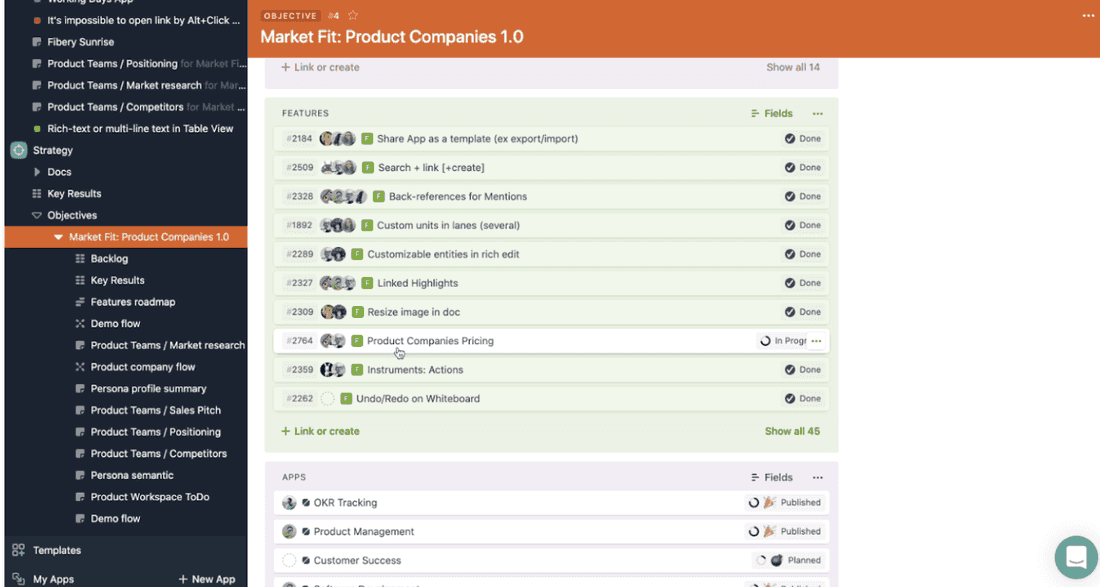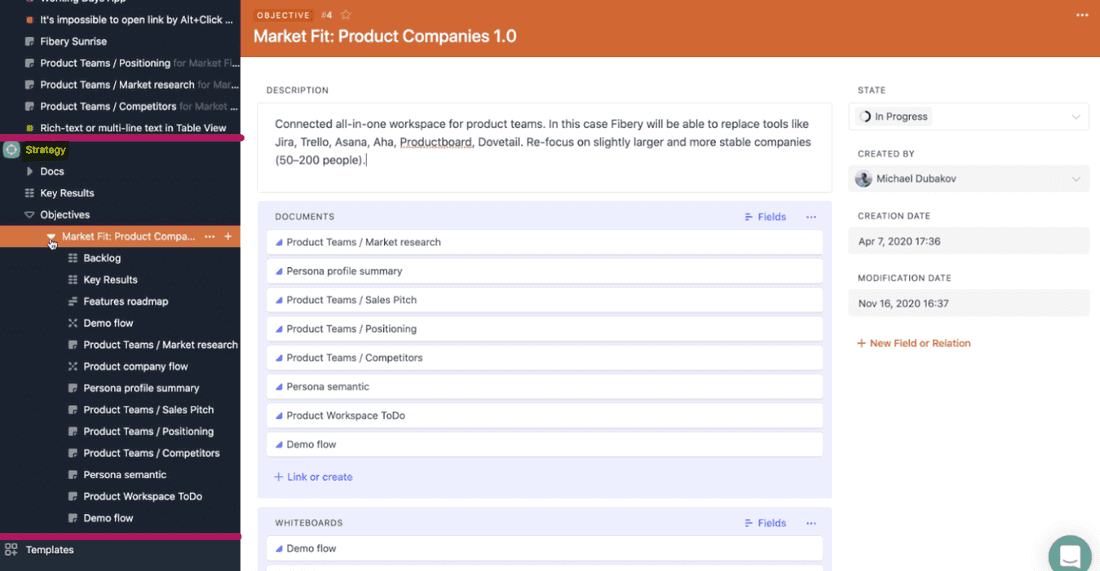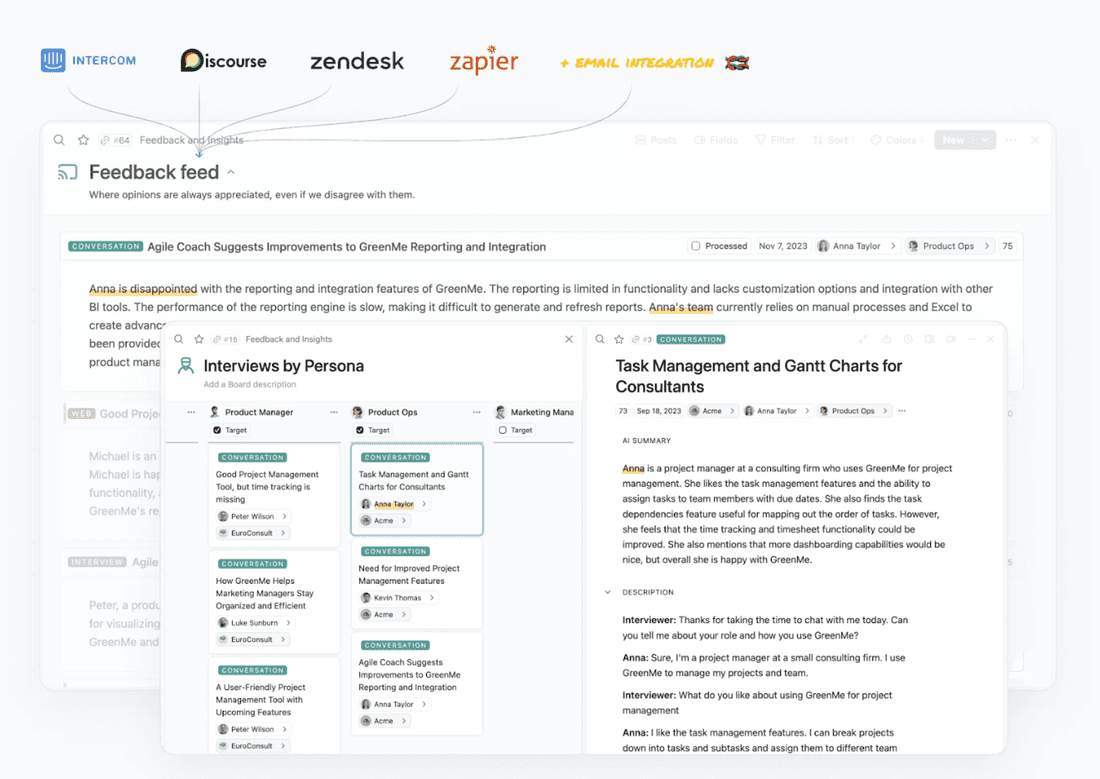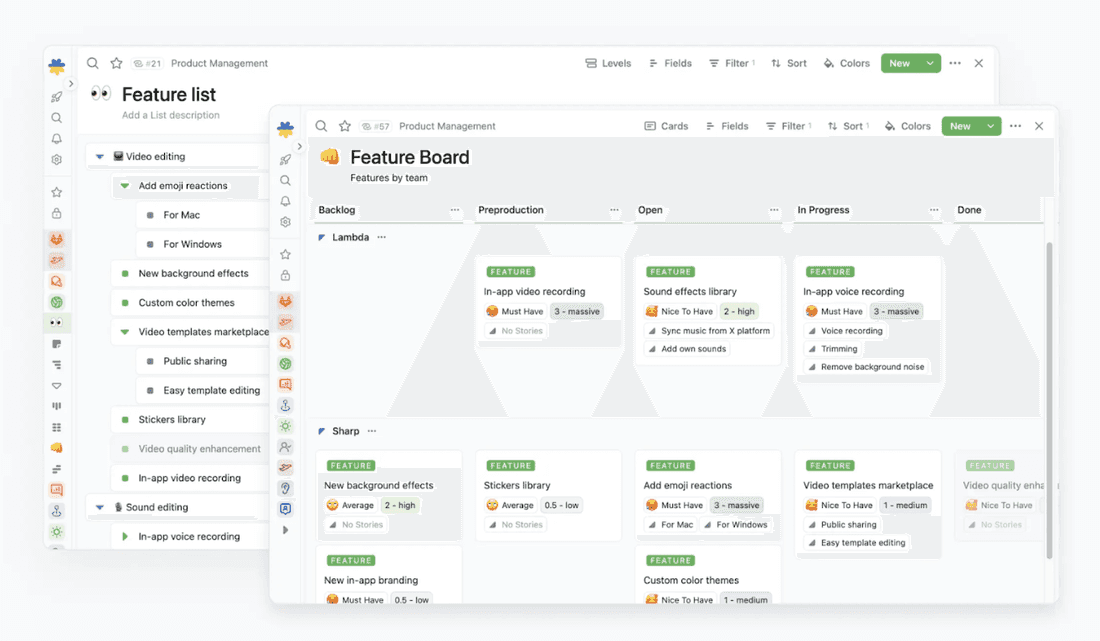Product Development Strategy Guide (2024 Update)
- What is a successful product development strategy?
- Why should you follow a product development strategy?
- What are the benefits of using a product development strategy?
- What types of product development strategies are there?
- What are the different product development strategies?
- Strategy 1: Exploring open innovation (proactive)
- Strategy 2: Improving existing features (reactive)
- Strategy 3: Extending your product line (proactive and reactive)
- Strategy 4: Expanding into new markets and industries (proactive)
- Strategy 5: Collaborating or building new partnerships (proactive)
- Strategy 6: Leveraging Reverse Innovation (proactive)
- Strategy 7: Acquiring or licensing new products or technologies (proactive)
- Real-life examples of companies successfully following product development strategies
- How Airbnb achieved a $1.9 billion profit by utilizing market expansion
- How Tesla is predicted to hold a trillion-dollar market cap by focusing on innovation and disruption
- How Spotify increased by over $80 million monthly active subscribers in just one year through collaboration and partnerships
- How Ford was named the most innovative volume brand in 2023 using reverse innovation
- How LEGO engaged users and achieved DKK $27.4 billion revenue in the first half of 2023 via co-creation
- The PM's hot take
- How Fibery manages your product development strategy
- Implement your product development strategy in real-time
As a product manager, your roadmap to success relies on a robust product development strategy.
66% of product development projects fail (or are significantly delayed) without carefully devised strategies for products your users desperately want.
But which strategies are suitable for your products?
This guide will help you navigate the complexities of product development strategy and understand its pivotal role. We’ll walk through various strategies, real-world examples, and actionable insights tailored to fuel your product’s journey from conception to raving success.
What is a successful product development strategy?
A product development strategy is a plan guiding the creation of new products or improvement of existing products from launch to market. It has four key phases, starting with your vision for the product:
- Product vision: What will the product be?
- Product strategy: How will this product meet business objectives while giving your users what they want?
- Product roadmap: How will the product be delivered? Who’ll do what by when?
- Product backlog: List of features and other requirements your product will meet.
You can’t create a product vision without knowing what your users want from you. So, once you’ve completed your product concept testing and market strategy, you’ll develop this four-part strategy.
Your product goals must align with your business objectives, so ensure your product vision shows not only how your vision will keep users happy but also works toward revenue or other marketing goals.
With your completed product vision, you’ll build a product development strategy to outline how you will develop your product. We’ll give you some strategies to consider in a bit. But first, a quick overview of the product development lifecycle.
Creating new products is more than thinking up an idea and deciding to make it. Your idea will pass through several defined stages to become a viable product.
Your goal is to move through these stages as effectively as possible. After all, you can’t spend two weeks in idea generation if you only have a month to get your product to market!
To survive the rigor of these stages, your product development strategy should:
- Understand your users’ needs: Delve into user and market demands to test how well a product idea or concept meets your potential customers’ needs.
- Align with business goals so you’re not only giving users what they want but also working within your business vision and goals. (Imagine if Apple launched a pair of shoes! It might be something users request, but it doesn’t align with their iVision, does it?)
- Prioritize time to market: Strive for a quick and efficient product launch while maintaining quality. We’re looking for quality, minimum viable product (MVP), not speed for speed’s sake.
- Create a proactive problem-solving culture: Anticipate and address potential issues throughout the development cycle.
- Seek iterative improvement through feedback cycles: Use feedback loops to gather user input and continuously enhance the product during development (without slowing down release).
Why should you follow a product development strategy?
Well, without one, products risk floundering in the market. Here’s why:
- Market relevance: Because a good strategy relies on integrating customer feedback and market research, you know before you start developing a product that it’s an excellent fit for consumer needs. This reduces the risk of launching a failed product and makes you more competitive in the market.
- Sales impact: Having a strategy to win business through a superior product, lower price, or other sales approach is more likely than a haphazard approach to boost product sales. Ultimately, that’s a goal, right? To sell your products and gain market share!
- Guiding path: Set a clear direction for the product team to follow so you can minimize status meetings and avoid micromanagement.
- Workflow optimization: Minimize the time (and resource) wastage and make teamwork easier because everyone knows what they should be doing when.
- Early problem identification: When you follow a data-driven strategy, you can monitor planned progress against your actual progress. This helps you see those roadblocks before you bump into them and develop proactive solutions. No more last-minute surprises!
Without a solid plan, inefficiencies and missed opportunities can lead to product failure. Nobody wants that.
What are the benefits of using a product development strategy?
Whether offering something new or positioning your product as the top choice among competitors, a product development strategy gives you the blueprint to move your product through the stages of development.
That blueprint helps you gain a deeper understanding of your product landscape to guide your decisions about what and when. By tapping into customer feedback and competitor insights, you’ll pinpoint where your product shines and where it can shine brighter.
So the strategy means knowing your target market, how you’re going to research what you need to know about it, how you’re going to approach development, and why and how the product will evolve.
Without this blueprint, you’re flying blind. Ultimately, it ensures your product has enduring and sustainable success in your ideal market, not to mention making you look really good! Hello, promotion!
What types of product development strategies are there?
With so many strategies to try, how do you choose? Introducing … The Ansoff Matrix. This matrix shows four strategic routes to company growth. You can use it to set your strategic direction about how you want to grow.
The Ansoff Matrix
The Ansoff Matrix, which has been around for generations, is a strategic planning tool to help organizations evaluate growth strategies. It is also known as the Product/Market Expansion Grid.
It presents four strategic growth options for businesses to consider:
- Market penetration: selling existing products in current markets by increasing market share, attracting new customers, or encouraging more frequent usage.
- Market development: introducing your current products to new markets or demographics by exploring geographical locations or targeting different customer segments.
- Product development: creating and launching new products or services for existing markets, catering to the needs or preferences of current customers.
- Diversification: venturing into new products and new markets, reducing risk by diversifying.
A given company might pursue strategic growth in more than one quadrant over time.
For example, a startup might have an idea for a new product first and then might classify that product idea as a new product in an existing market, or even a disruptive new market. A more mature company with many products might move in multiple quadrants simultaneously.
The Ansoff Matrix helps you identify how your company (or product) will grow. That choice affects the strategies you will apply. Those may be either reactive or proactive.
Proactive vs. reactive
The key difference between these two categories is that organizations drive their own direction with proactive strategies and respond to the outside (customers and competitors) with reactive strategies.
We’ll categorize the different strategies under one of these two headings as we move through them.
What are the different product development strategies?
So, how many strategies are there?
Strategy 1: Exploring open innovation (proactive)
With this strategy, you’re creating new products or services that address unmet needs or offer unique features.
Embracing open innovation involves breaking down internal barriers and inviting external contributors, like opening your kitchen to friends and chefs from different backgrounds to exchange expertise to cook up something unique.
As brainstorming sessions gather diverse perspectives, open innovation cultivates collaboration over competition.
Strategy 2: Improving existing features (reactive)
The most reactive of the strategies outlined, this strategy relies on making improvements based on user feedback or product insights. Based on your market’s needs, you focus on enhancing or modifying existing products to improve features, quality, performance, or cost-effectiveness. You’ll see below how we here at Fibery use this approach and manage it all in one place!
Strategy 3: Extending your product line (proactive and reactive)
Depending on the data driving this decision, you could consider this strategy reactive or proactive. For example, suppose you’re expanding based on open innovation. In that case, this is proactive, but if you are responding to client feedback or defending against the competition, you are reacting to your target market’s needs.
It involves expanding an existing product design or line by introducing variations or new versions to cater to market segments or preferences.
Examples of this approach might be a clothing brand introducing new apparel designs or colors in a popular line. Or a smartphone company unveiling upgraded models to address different user preferences for camera quality, battery life, or screen size. 📲
Strategy 4: Expanding into new markets and industries (proactive)
With this proactive strategy, you’ll introduce an existing product into new markets or demographics by adapting it to fit different needs. That’s how Uber took the food delivery model and applied it to revolutionize the taxi industry. Look at market trends in other industries and experiment with how they could be adapted to suit your objectives. Who knows what you could come up with! 🤯
Strategy 5: Collaborating or building new partnerships (proactive)
Try working with other companies or experts to co-create or develop new products using combined resources. While this might seem scary initially, think about some of the most popular recent collaborations in the tech industry: Beats by Dre.
Strategy 6: Leveraging Reverse Innovation (proactive)
Developing products initially for emerging markets and later introducing them to developed markets has worked well for businesses like Gatorade and Aeropress. What could it do for you?
Strategy 7: Acquiring or licensing new products or technologies (proactive)
Acquiring existing products has enhanced Nestle’s product portfolio, which, in 2018, made a $7.15 billion licensing deal to sell Starbucks coffee products exclusively. Is there a technology or product you could develop by licensing or acquiring someone else’s products?
Real-life examples of companies successfully following product development strategies
With these strategies in mind, here are some real-world examples in action.
How Airbnb achieved a $1.9 billion profit by utilizing market expansion
Company: Airbnb 🏡
Strategies: Market expansion, responding to customer requests, and innovation
Impact on profits: By expanding beyond just a platform for people to become hosts or book accommodations, in 2022, AirBnB expanded into more regions while also providing tools for hosts with the release of AirBnB Setup, which connects hosts with Super Hosts to better prepare their homes for rental, and AirBnB-Friendly Apartments for long-term renters to sublet their apartments when they are away.
This innovation extended AirBnB into new regions and markets while opening additional revenue streams. This is particularly interesting as AirBnB is really a tech company that leverages other people’s properties. Still, their clever product strategy has enabled them to build on this foundation with additional product offerings such as AirCover insurance.
How Tesla is predicted to hold a trillion-dollar market cap by focusing on innovation and disruption
Company: Tesla 🚗
Strategy: Innovation
Impact on sales: Tesla’s relentless focus on innovation in electric vehicles, battery technology, and autonomous driving systems will lead to a predicted trillion-dollar market cap in 2024.
Their groundbreaking products, such as the Model 3, not only revolutionized the electric vehicle market but also attracted a massive customer base, driving unicorn-like sales growth for the company.
How Spotify increased by over $80 million monthly active subscribers in just one year through collaboration and partnerships
Company: Spotify 🎶
Strategy: Collaboration and partnerships
Impact on subscribers: Spotify’s strategic collaborations with companies like Samsung, artists for exclusive content, and device integrations resulted in an astounding increase in subscriber numbers.
These partnerships expanded the reach of Spotify’s music streaming service, attracted new users, and significantly boosted subscriber growth.
How Ford was named the most innovative volume brand in 2023 using reverse innovation
Company: Ford Motor Company 🚙
Strategy: Reverse innovation and market expansion
Impact on sales: It’s no easy feat to stay at the forefront of innovation for 120 years, but that is what Ford has achieved since the production of its first motor car in 1903. Ford was named the most innovative volume brand in 2023 at the Automotive Innovation Awards.
Where Tesla’s disruption of the traditional automobile industry focuses on new technologies, Ford’s adoption of reverse innovation strategies, by developing affordable and robust vehicles for emerging markets like India and Brazil, led to an impressive increase in global sales.
The success of these models influenced the design and features of vehicles sold in more developed markets, contributing to Ford’s substantial sales growth worldwide.
How LEGO engaged users and achieved DKK $27.4 billion revenue in the first half of 2023 via co-creation
Company: The LEGO Group 🏰
Strategy: Co-creation with users
Impact on sales: The LEGO Group’s innovative approach of engaging users through platforms like LEGO Ideas, where fans can submit designs, and the wildly popular LEGO movies, LEGO not only boosted sales but also fostered a stronger community and customer loyalty.
LEGO is not just another toy company, but a toy empire embedded within our culture and shows no signs of stopping.
The PM’s hot take
First, figure out the vision. If that’s done, move on to figuring out how to reach that vision. The latter will be your product development strategy. Sure, follow frameworks all day if you want, but that’s the problem you’re trying to solve. Which users will you target first, second, and so on? Which problems will you solve for your users first, second, and later? As we often say, the strategy is only as good as the PM who deploys it. If you know where you are heading, many of the tips in this article will be handy, but if you don’t - you might want to go back to the drawing board.
How Fibery manages your product development strategy
You can use Fibery across your entire product process, from idea generation to ongoing improvements. However, Fibery excels at helping you build your product development documentation, including a product vision, product strategy, and product roadmap. 🎉
Plus, you can manage your product from ideation to launch to modifications all in the same place!
Here’s how Fibery manages its own product development – in Fibery!
Create your product vision in Fibery
At Fibery, we define the main strategic theme for the quarter. Say our current objective is to release Fibery for product companies and find a market fit. First, we do market research, write a couple of analytical documents, and attach them to this objective. You can see the key results table and features roadmap in the menu on the left, which are also all attached to the same objective.

This keeps everything organized in one place and shows the level of detail that goes into a well-researched objective that meets user needs and aligns with Fibery’s business strategy.
Develop your product strategy
With all of your research documented, you can begin to outline your strategy:

Everything is there in the left-hand menu, including market research, backlog, testing results, marketing user personas, sales pitch, and positioning!
Create your product roadmap
With the vision and strategy locked in, it’s time to build the features roadmap, which you can access from the same left-hand menu.

As well as the documentation processes, Fibery can also help you manage and complete your research and track your metrics after launch. Here are some other cool things you can do in Fibery:
Accumulate user feedback in one place:
- Involve users directly in the product development process to align products with their preferences.
- Gather feedback and suggestions directly from users to create products that resonate with their expectations.
- Align product features and functionalities with customer preferences to improve market acceptance and product adoption rates.
This customer-centric approach fosters a sense of ownership among users, enhancing loyalty and satisfaction with the final product.

Get user insights
You can extract data from your users with Fibery’s insights to see which features need the most attention or could be your ticket to increased user satisfaction:

Prioritize your features to make the next strategy session seamless
Then prioritize these features with Fibery’s product hierarchy so as you put your strategy together, you can see which features should be developed first:

To find out more about how Fibery uses Fibery to manage its own product development, read here.
Implement your product development strategy in real-time
Fibery isn’t just software; it’s your development team’s secret weapon in product development. It can be used throughout the entire product development process from idea generation to launch.
It’s like a virtual Swiss Army knife, bringing together everyone’s ideas, plans, and tasks in one organized hub. Think of it as your team’s magic wand—transforming chaos into collaboration. Stop wasting time switching contexts and manage your product from idea to success in one place.
With Fibery, you’ll breeze through brainstorming sessions, keep track of progress effortlessly, and turn concepts into actionable plans. It’s the glue that keeps your team connected, simplifying workflows and boosting productivity.
By streamlining communication and task management, Fibery becomes your trusted partner, ensuring a smoother journey from idea to successful product.
Psst... Wanna try Fibery? 👀
Infinitely flexible product discovery & development platform.